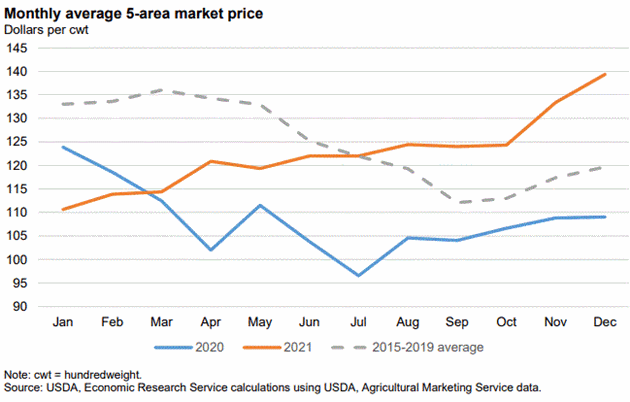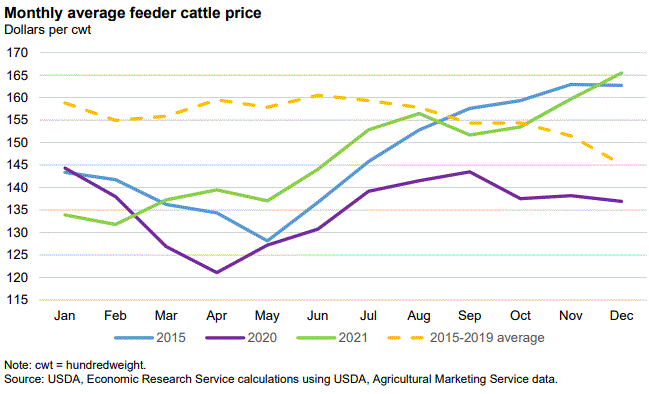Source: 2022 USDA, Economic Research Service
Feeder and Fed Steer Prices Raised in 2022
The 2021 average price for feeder steers weighing 750-800 pounds sold in the Oklahoma City National Stockyards was the highest since 2015. As illustrated in the chart above, the 2021 average feeder steer price was mainly on par with the 5-year average (2015–19) steer price from August through October but surged in November and December of 2021. The feeder steer price for the week ending January 10 was $156.65 per cwt, up 14.2 percent, or $19.13, from a year ago. Based on current price strength, the first and third-quarter forecasts for feeder steers were raised by $1.00 to $159.00 and $160.00 per cwt, respectively compared to last month, while the second-quarter forecast was increased by $2.00 to $156.00. As a result, the 2022 annual forecast was raised by $1.00 to $160.00 per cwt relative to last month.
The expansion in beef production was the result of an increase in the pace of slaughter likely supported by continued strength in packer demand. The average price for all grades of live steers sold in the 5-area marketing region for December was reported at $139.36 per hundredweight (cwt), up 27.8 percent, or $30.31, from December 2020. From August to December, the 2021 average 5- area market price exceeded the 2015-19 average steer price. During this period, the average 5-area steer price increased 12.0 percent, or $14.91. The average fed steer price for the week ending January 9 was $138.41 per cwt, up 24.4 percent, or $27.14, from a year earlier. The 2022 first- and fourth-quarters forecasts for fed steers were increased by $1.00 to $139.00 and $138.00 per cwt relative to last month, while the forecasts for the second and third quarters were raised by $2.00 to $1.36 and $1.34 per cwt compared to a month ago. These increases in fed steer prices are based on expected continued strength in packer demand. The 2022 annual forecast was raised by $1.50 to $136.75 per cwt from a month ago.

Cow and Bull Slaughter and Dressed Weights Lift Production
Beef production in 2021 is expected to total 27.950 billion pounds, up 55 million pounds from last month’s forecast. This increase is driven by a more rapid pace of cow and bull slaughter as well as by heavier cattle dressed weights. Beef cow slaughter in December was up more than expected, likely reflecting the drought in the Western region of the country. According to the USDA Agricultural Marketing Service (AMS) Livestock Slaughter report, total estimated Federally Inspected slaughter for December was up 1.5. percent above a year ago, while cow and bull slaughter rose 5.8 and 5.3. percent, respectively, above last year’s levels. Heavier dressed weights also contributed toward the increase in beef production. AMS weekly livestock slaughter reported for the week ending December 25 showed that average dressed weights were almost 10 pounds (1 percent) above the same week a year ago, and 13 pounds greater than the 3-year average for the same period. Overall, December average dressed weights are estimated to be 3 pounds heavier than in November, but little changed from a year ago.
Net placements were raised for the 2021 fourth quarter, partly on stronger-than- expected cattle movement into feedlots during November. Given the anticipated rise in fourth-quarter net placements, fed cattle marketings and fed cattle slaughter expectations are raised in the second quarter and coupled with a stronger expected pace of marketings in the second half of the year, the beef production forecast is raised for 2022. The forecast for the 2022 beef production was raised to 27.165 billion pounds, up 165 million pounds from last month.













